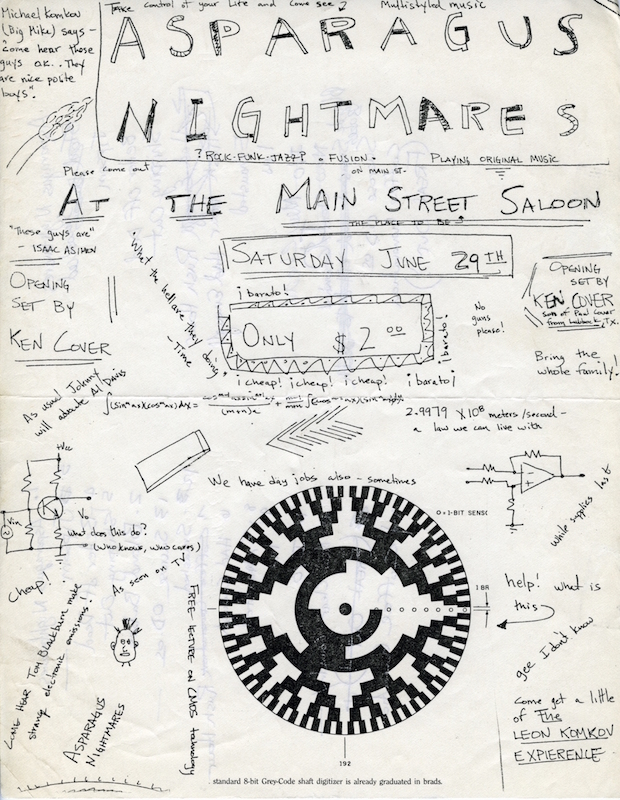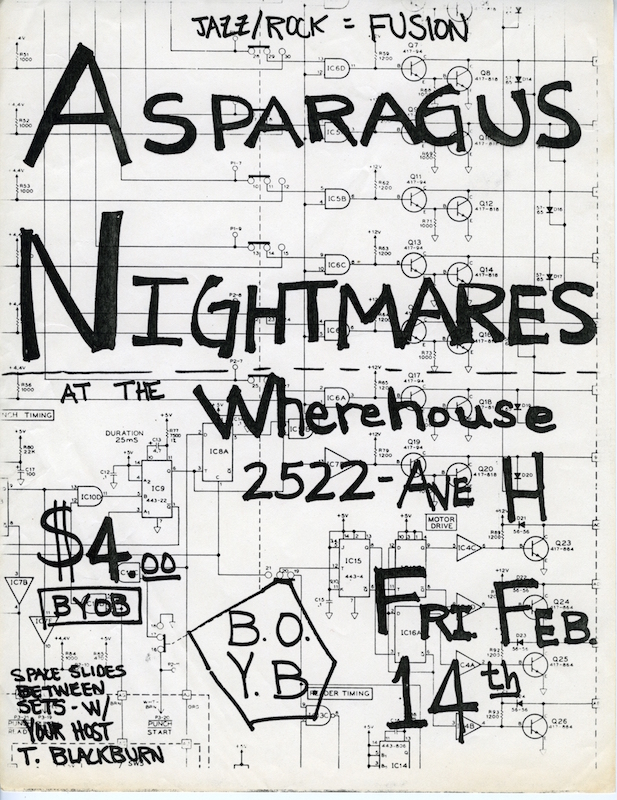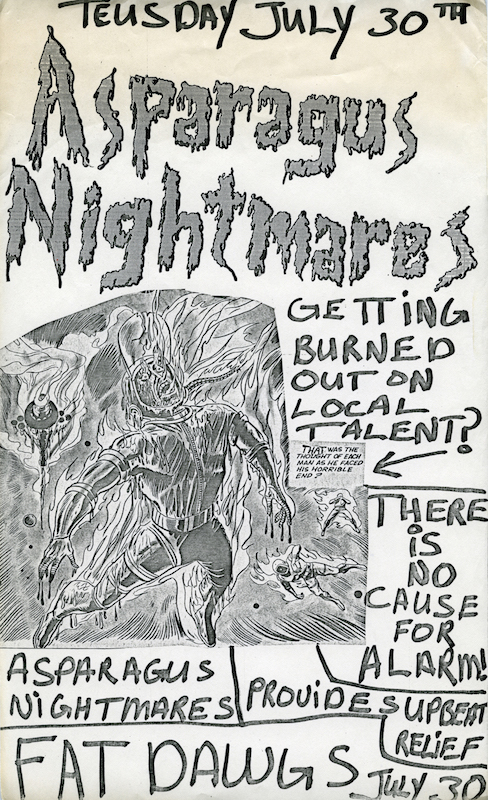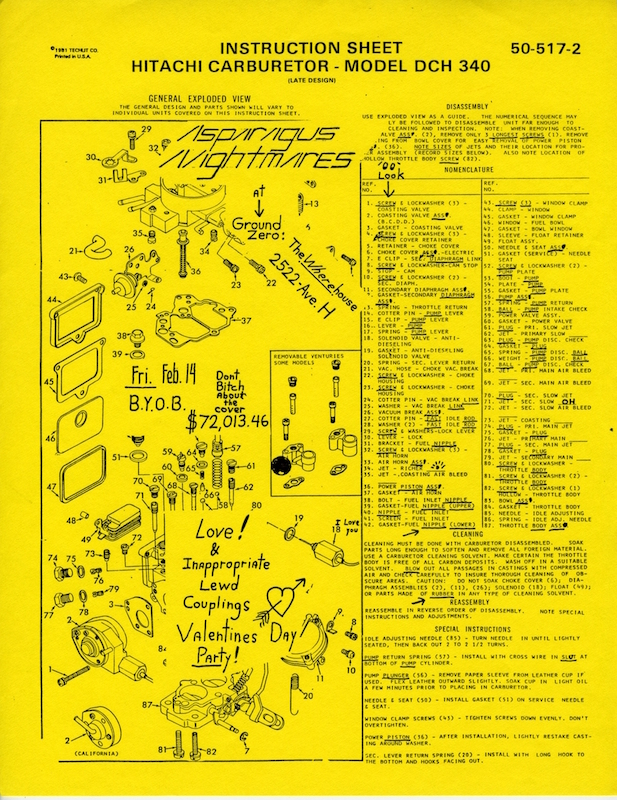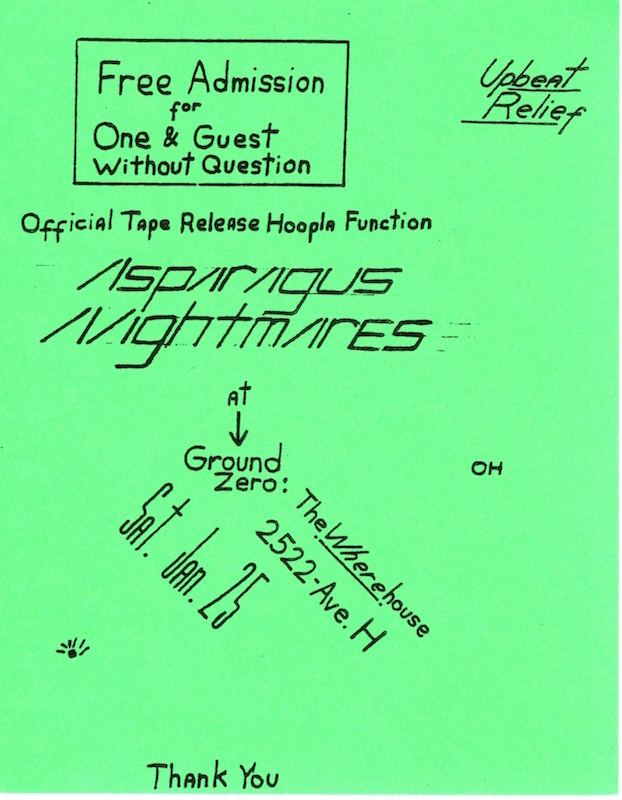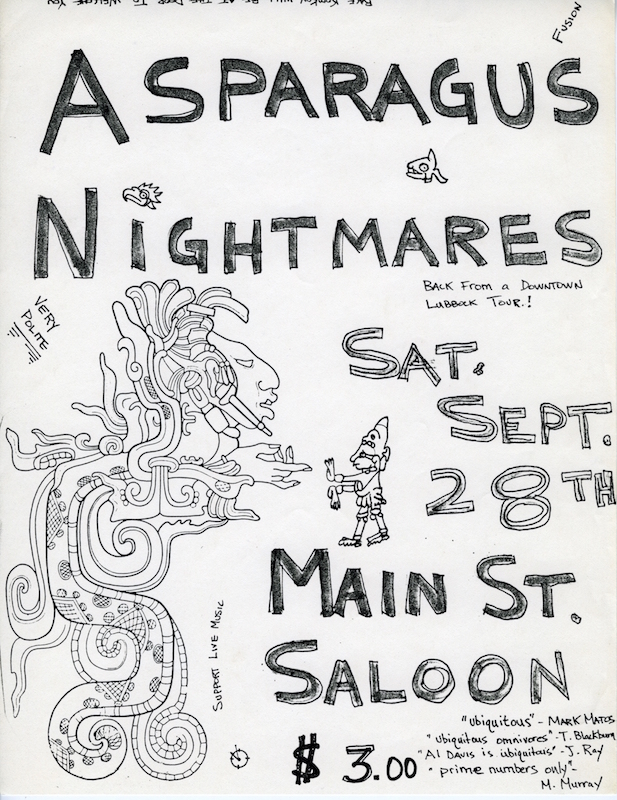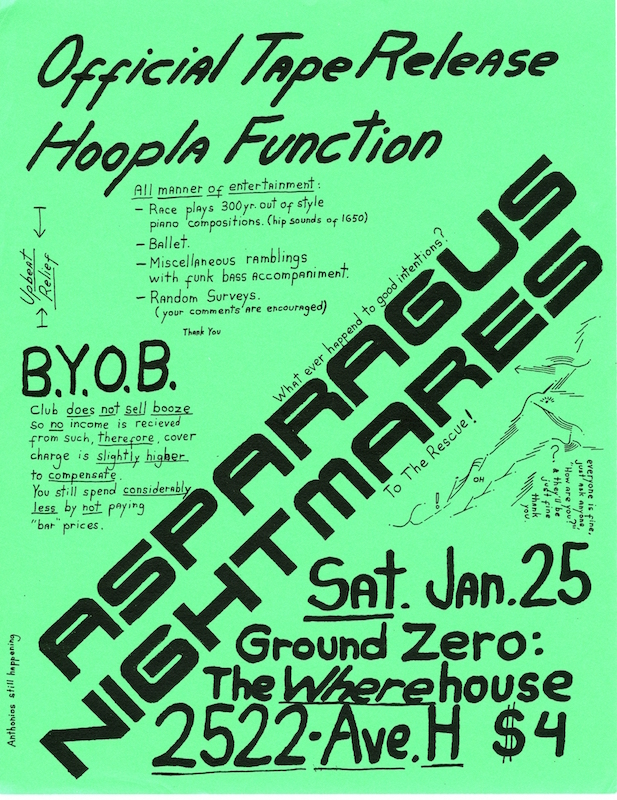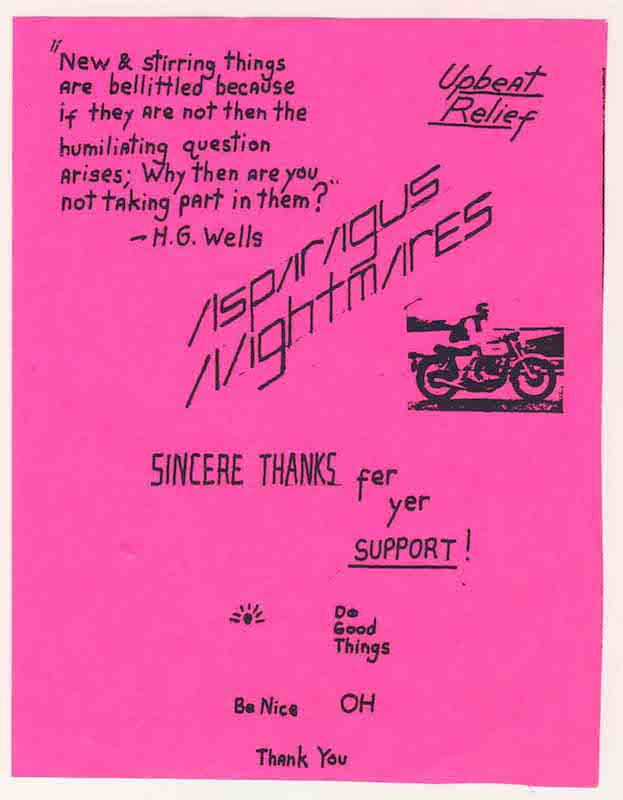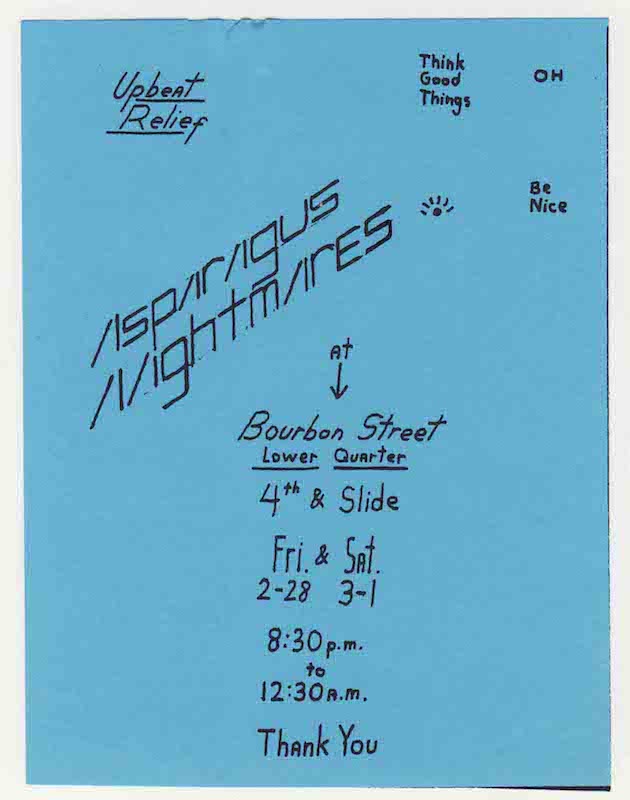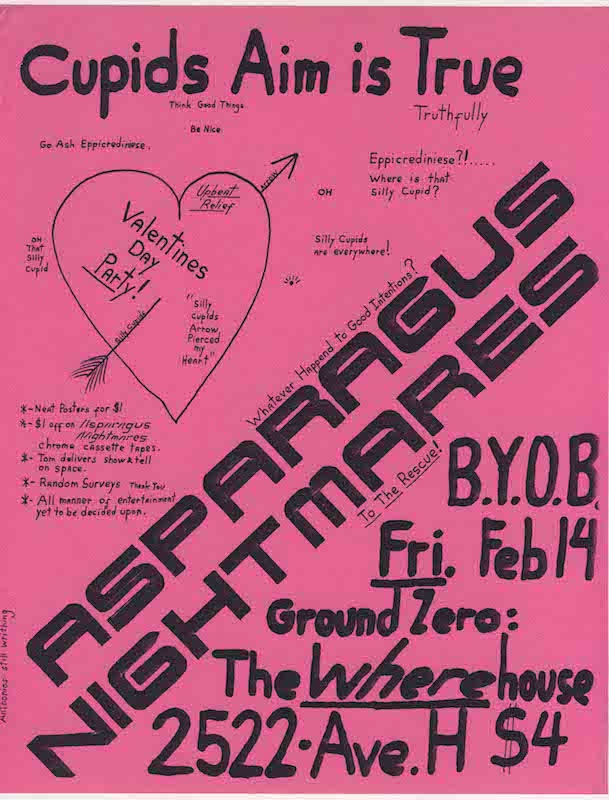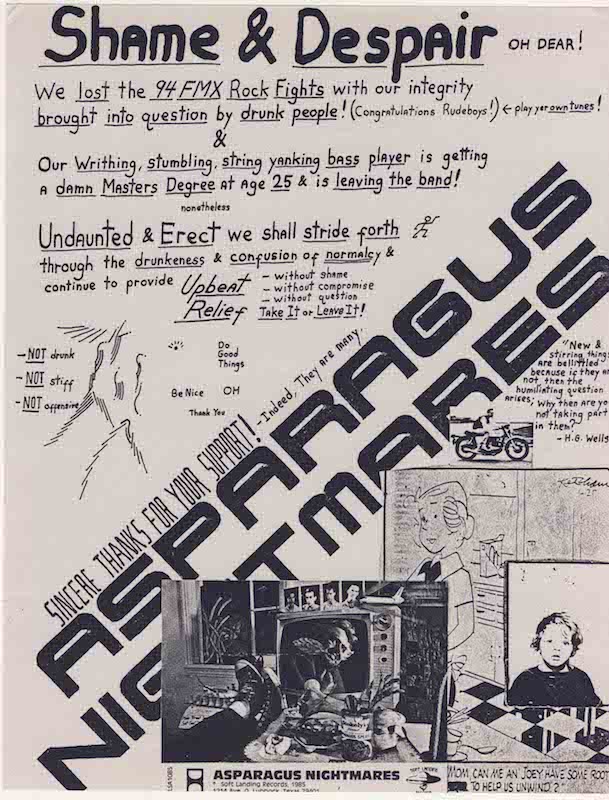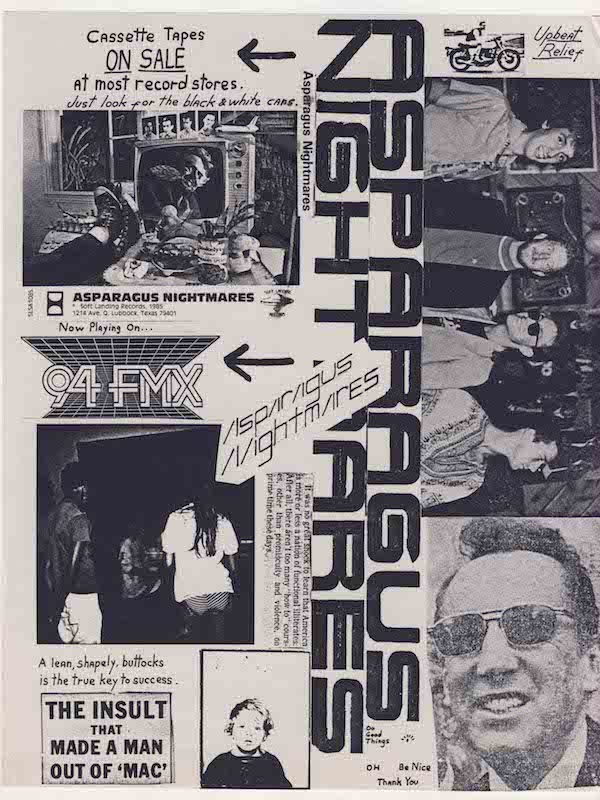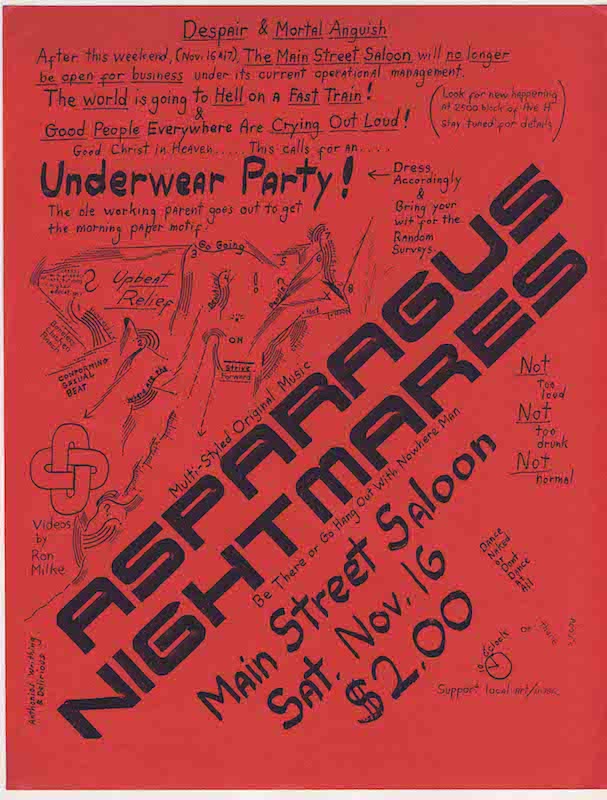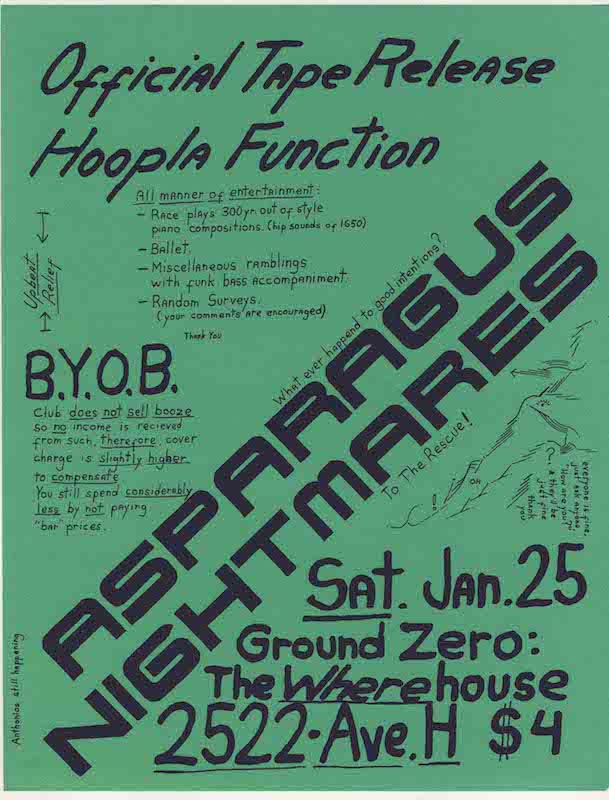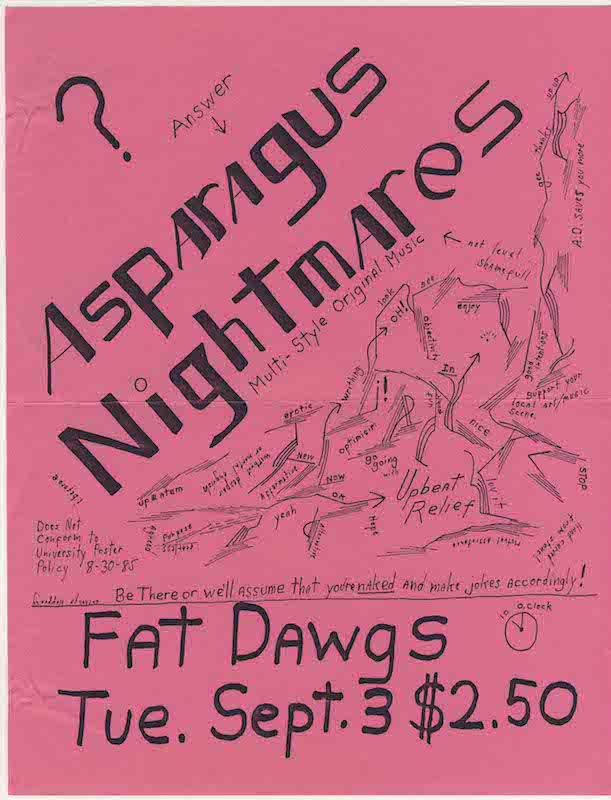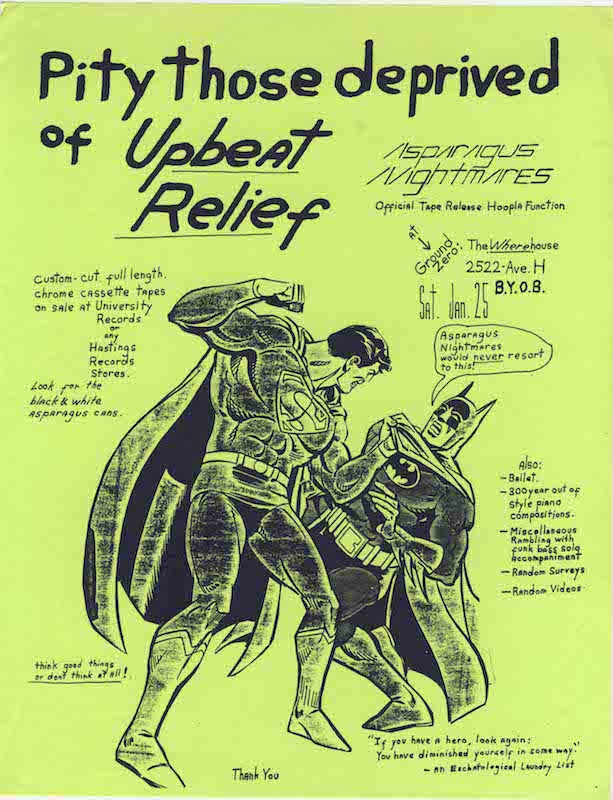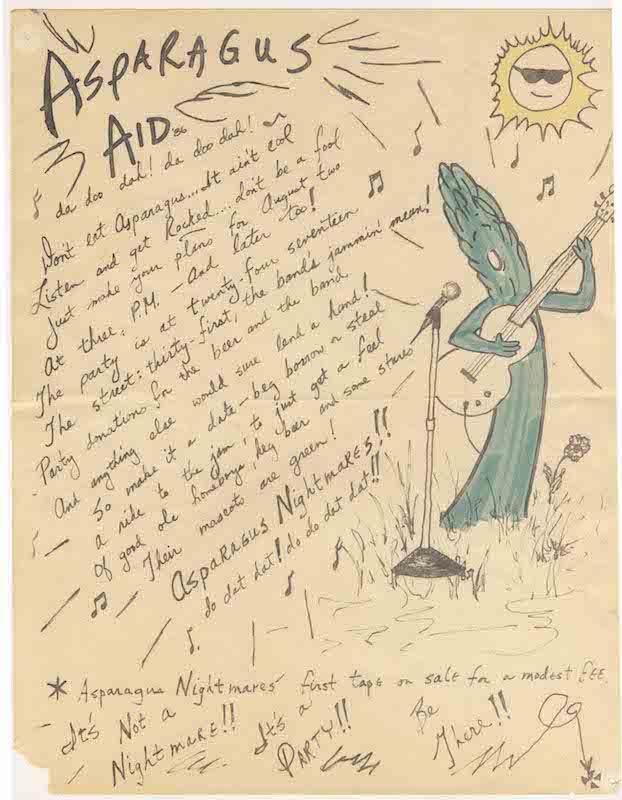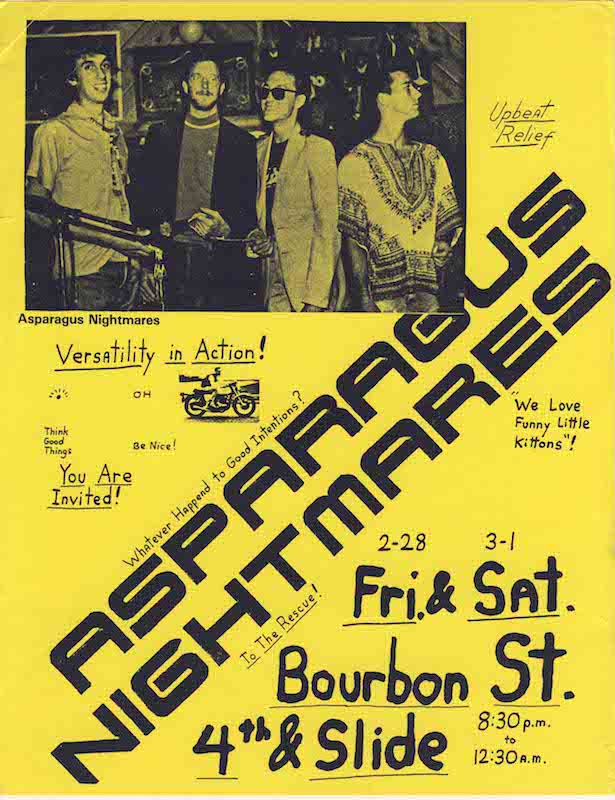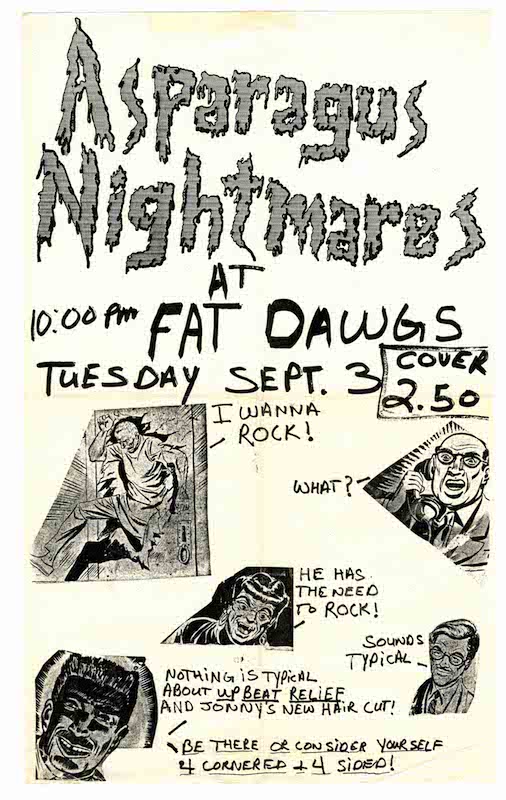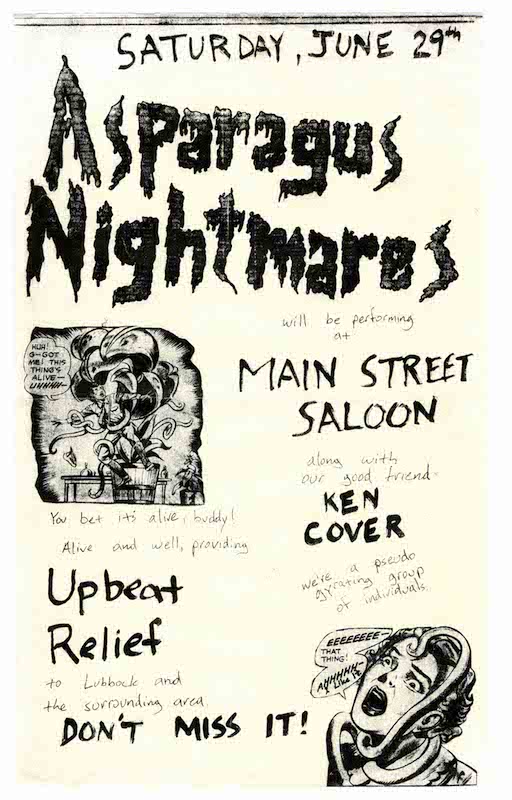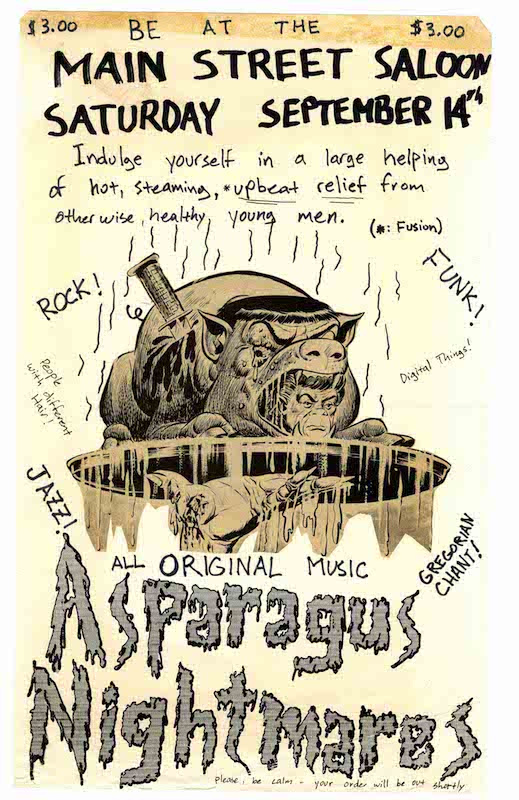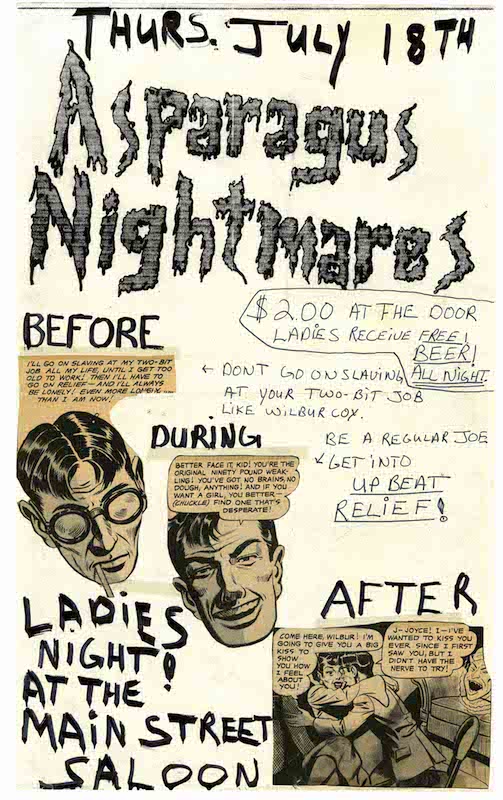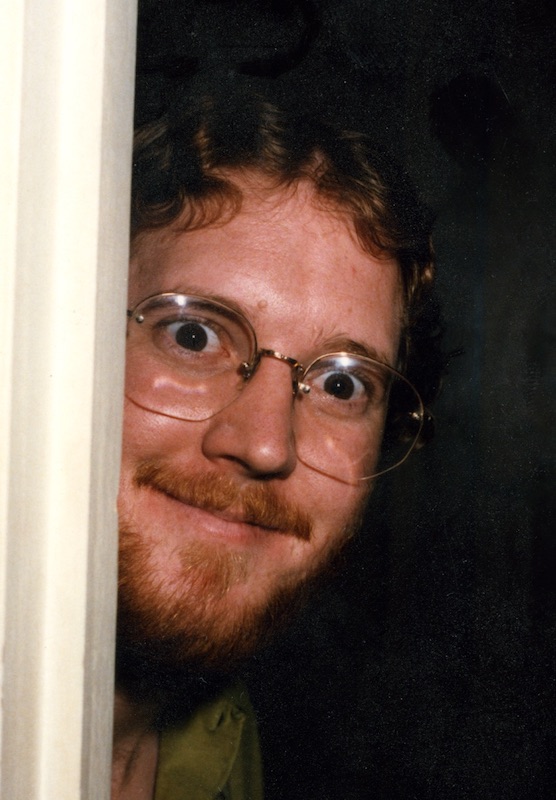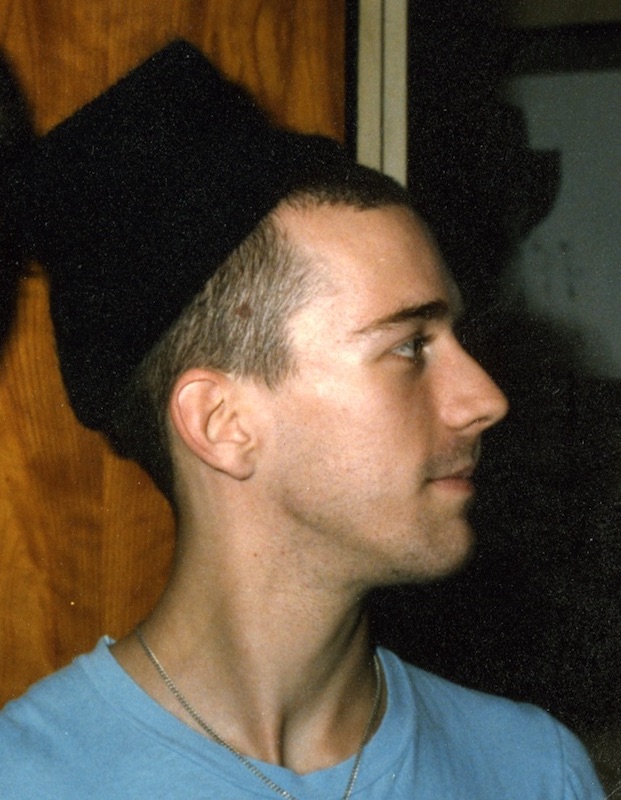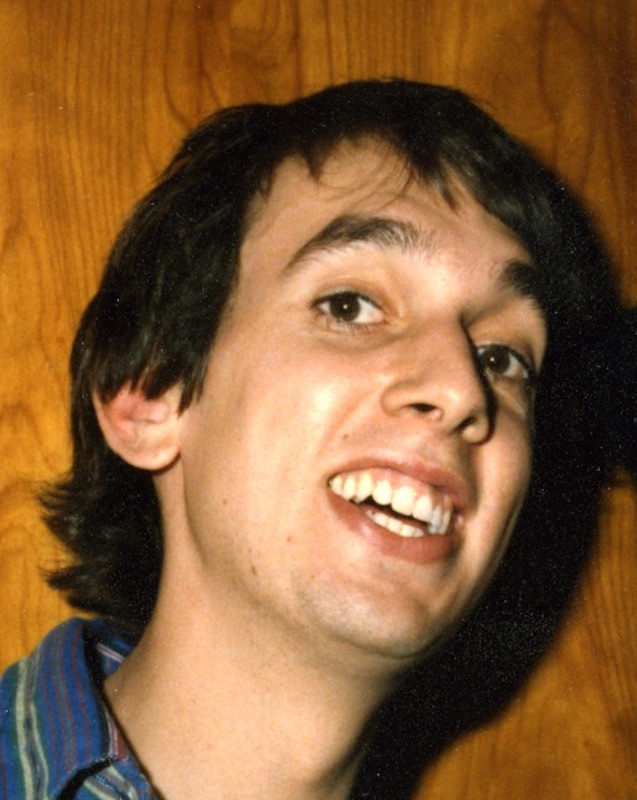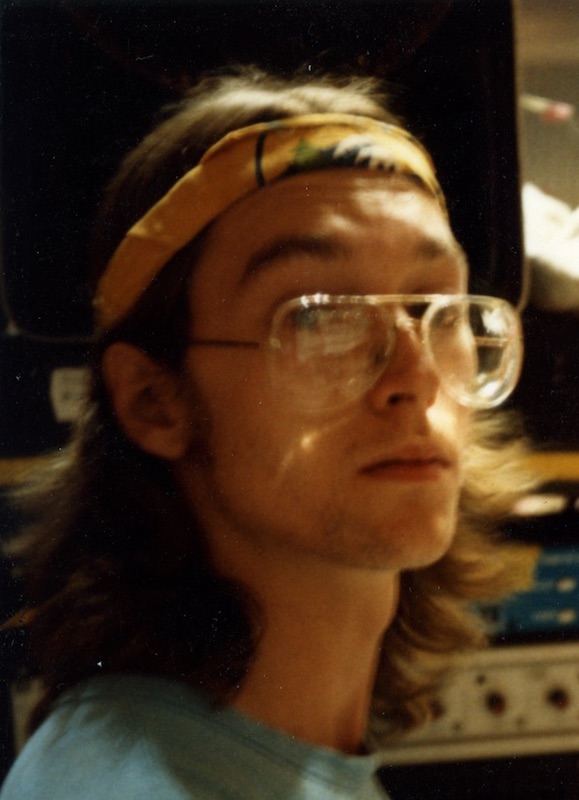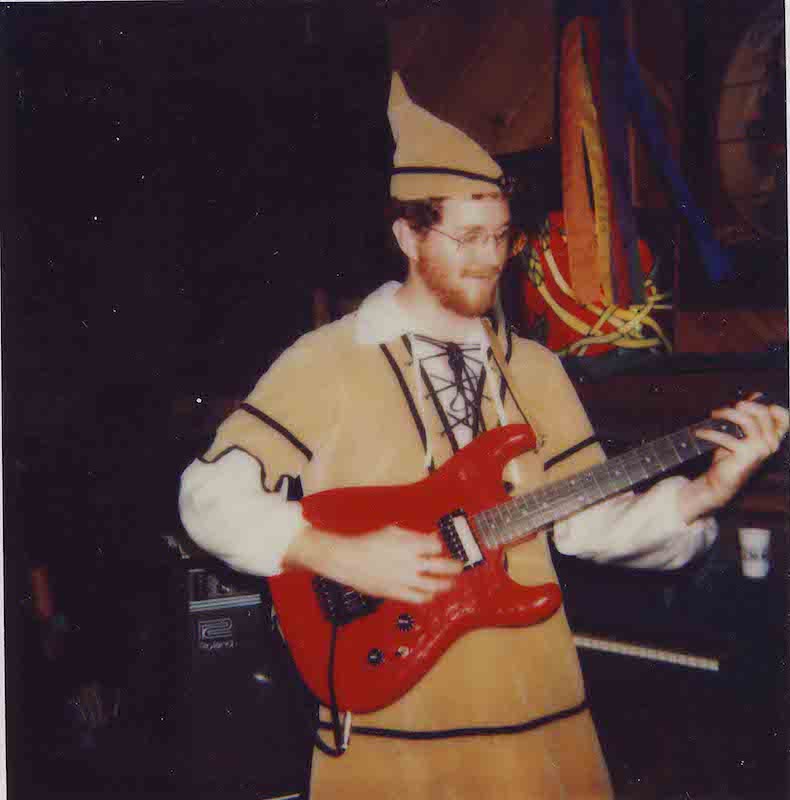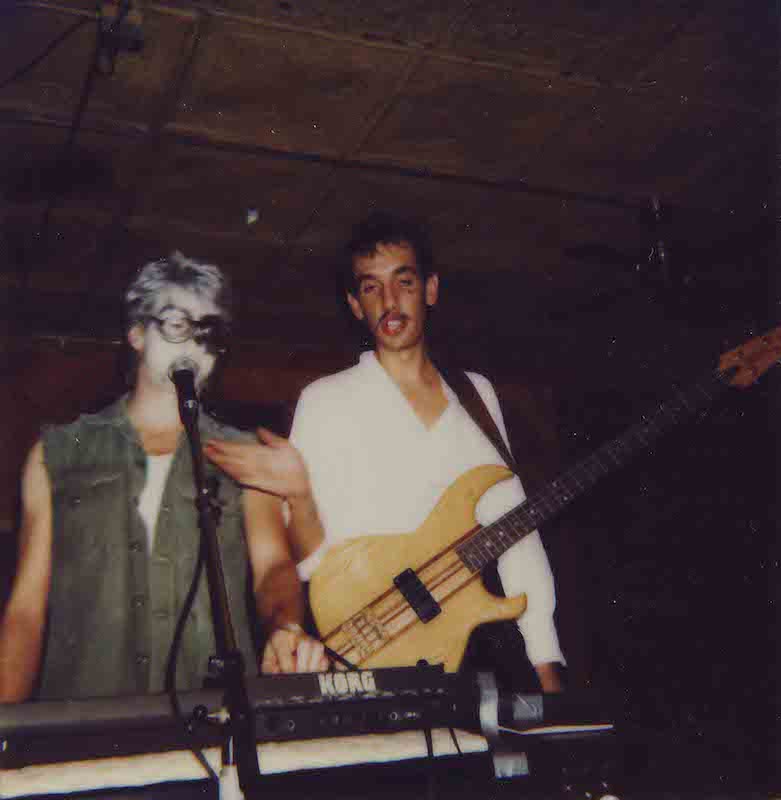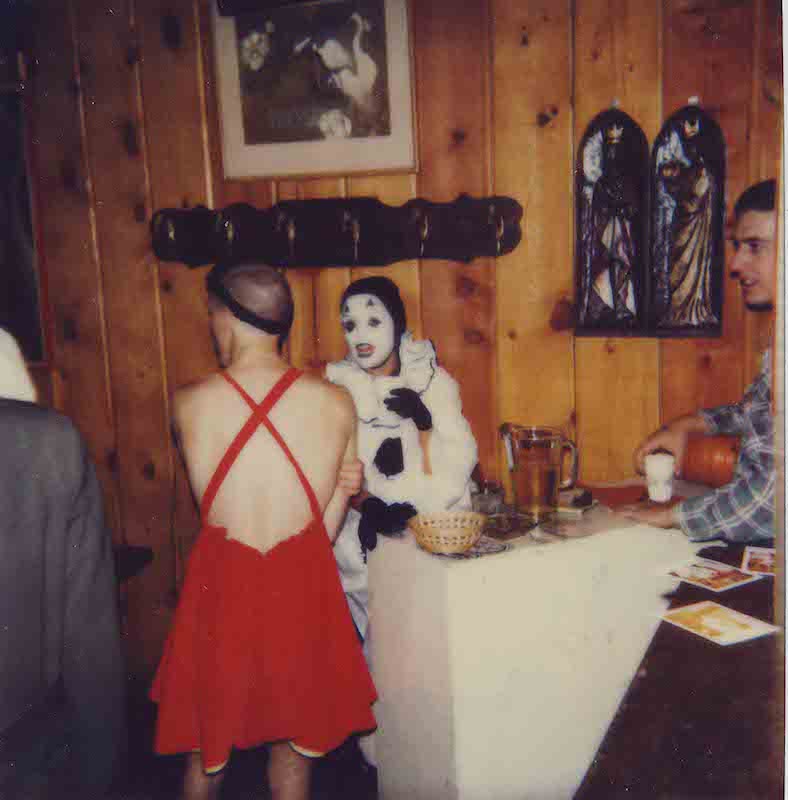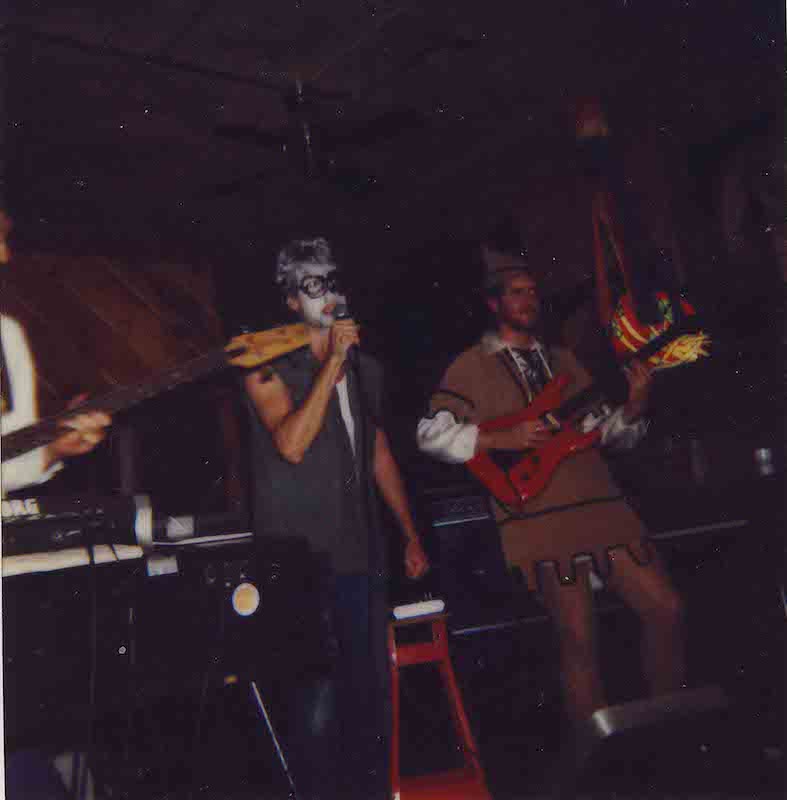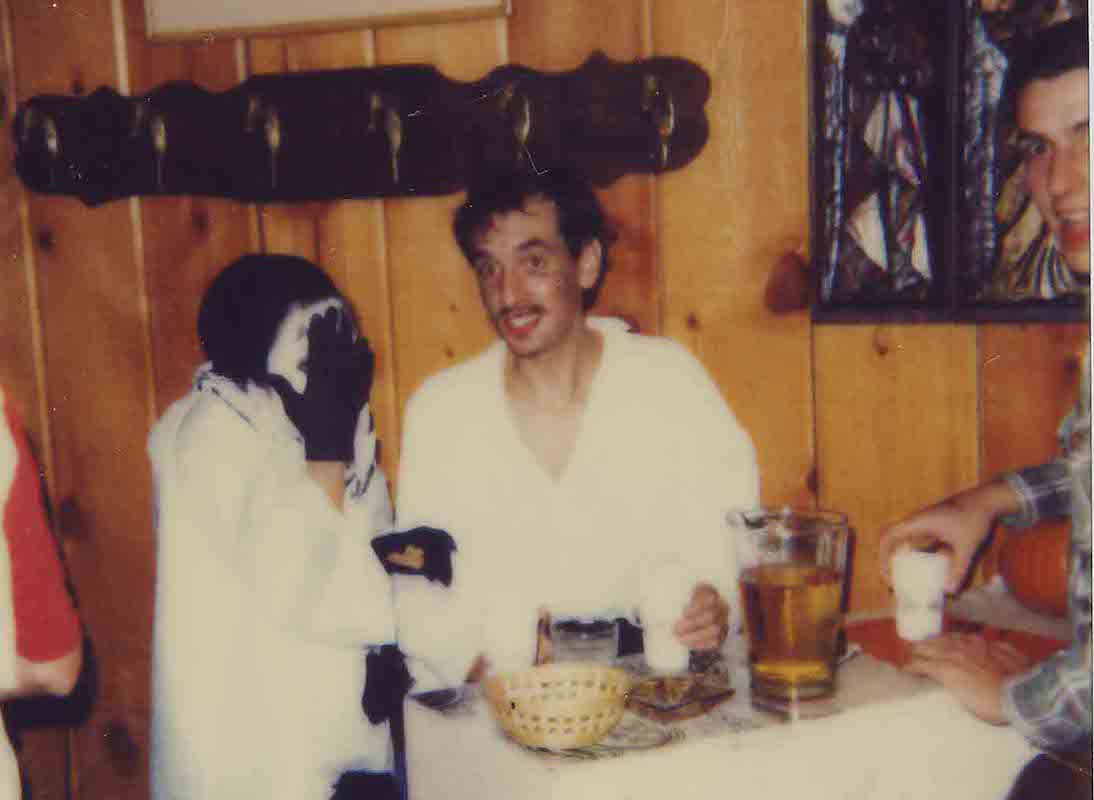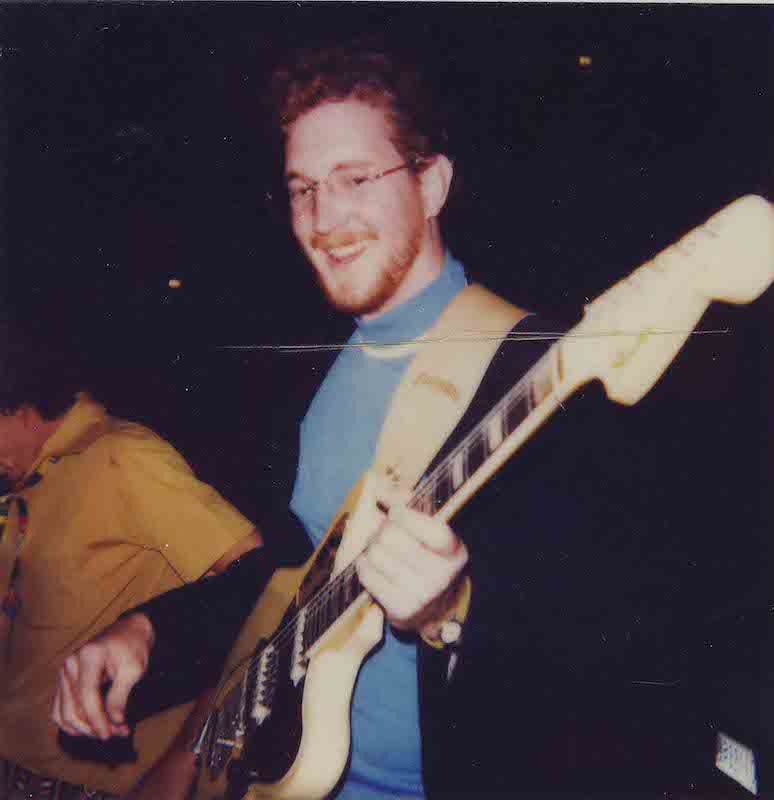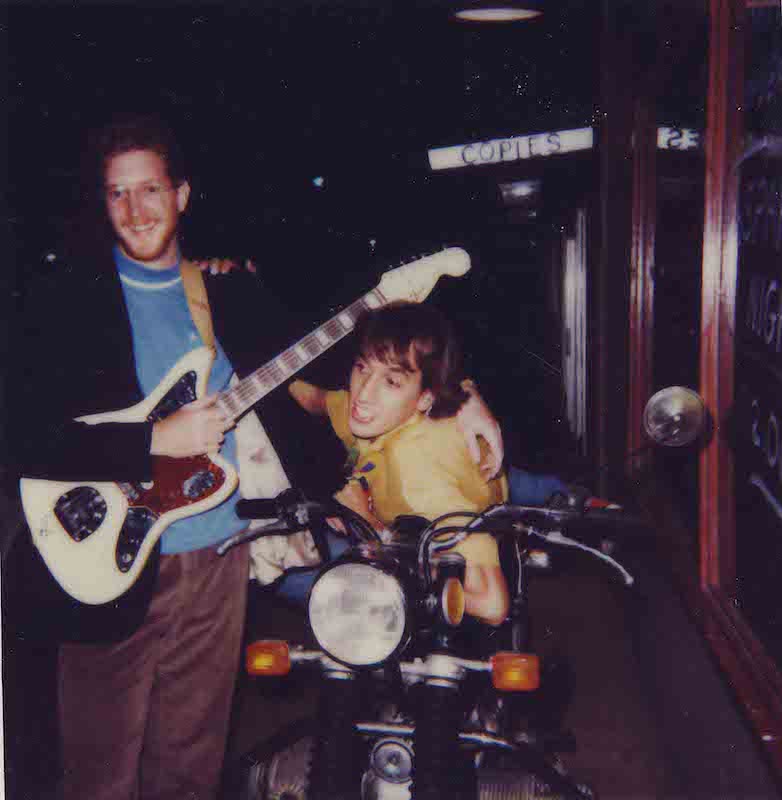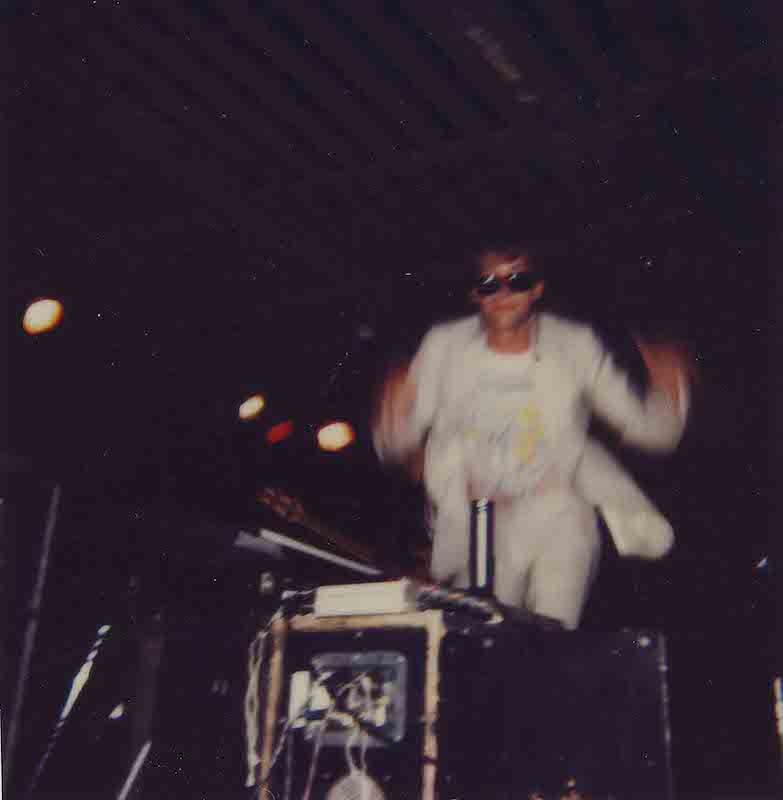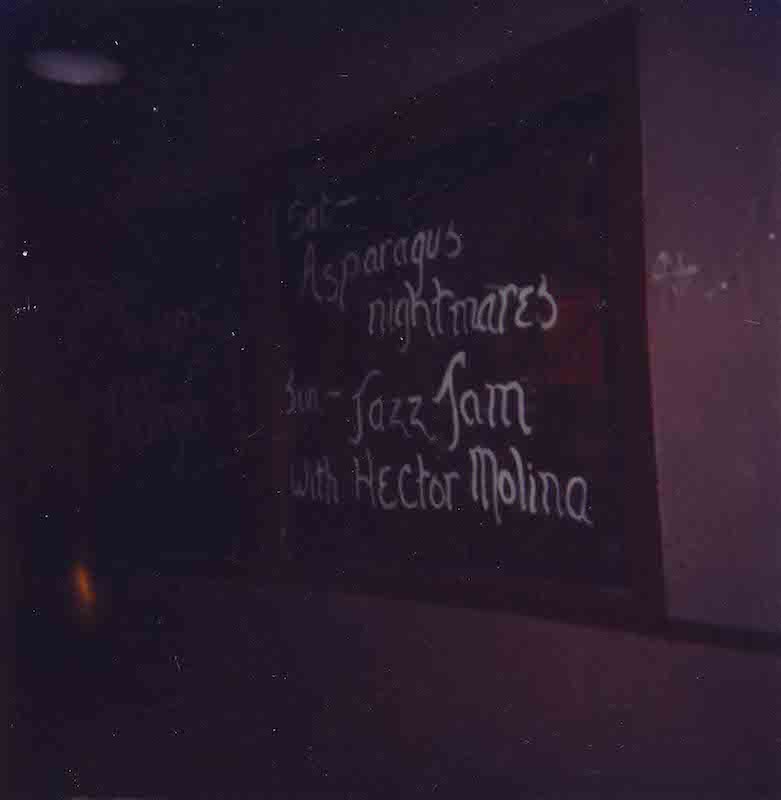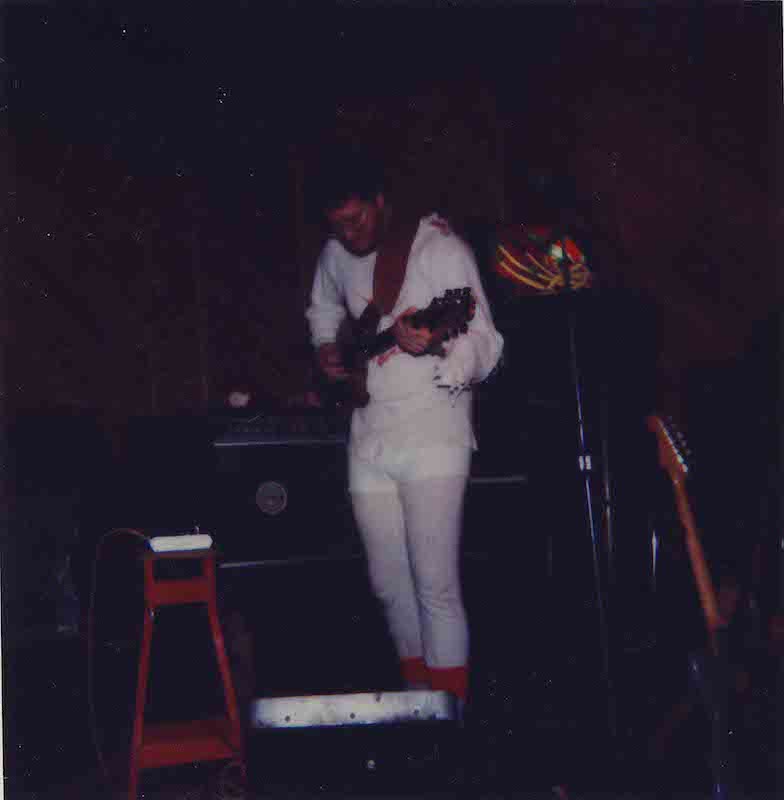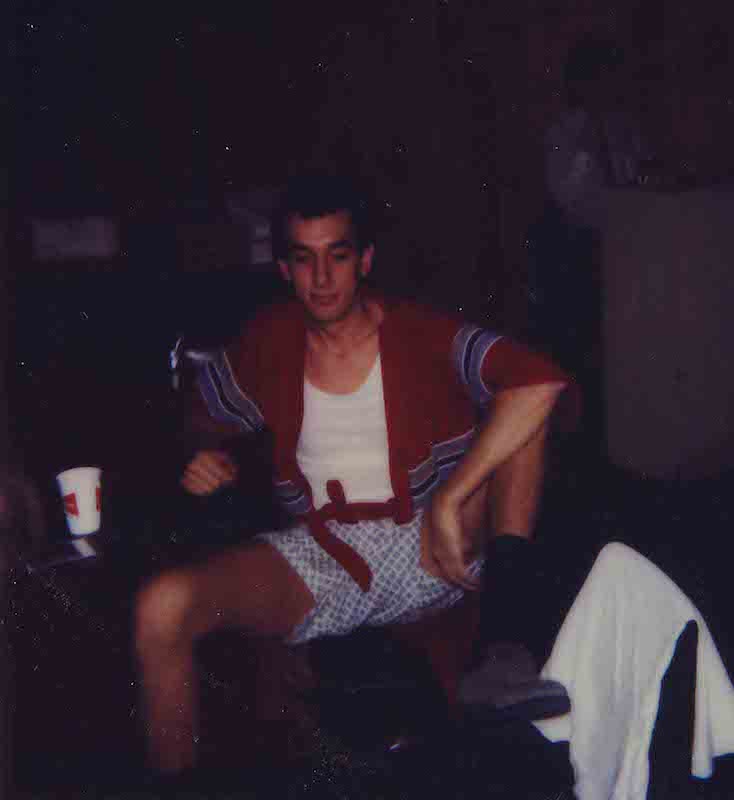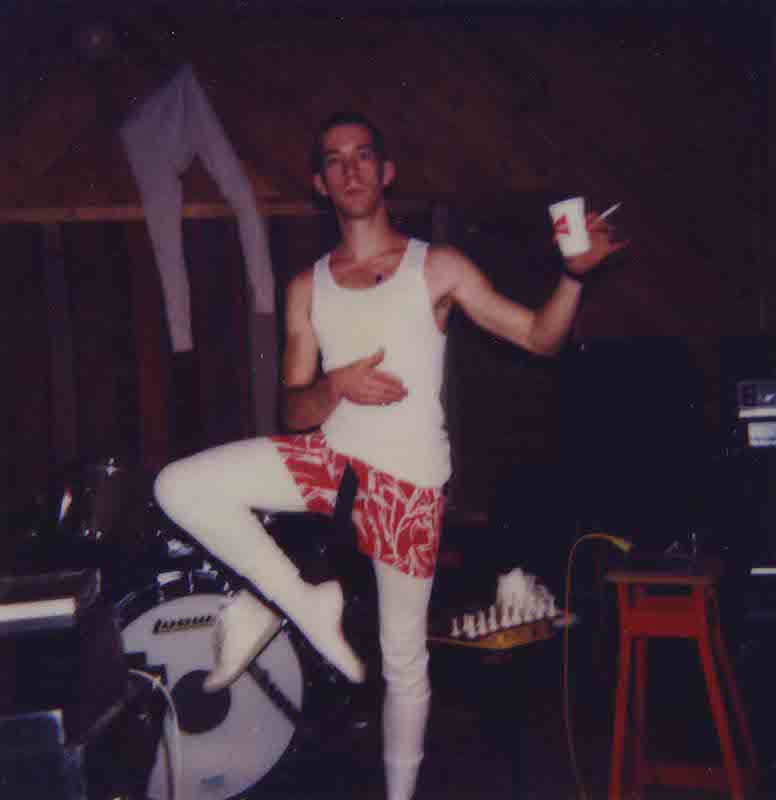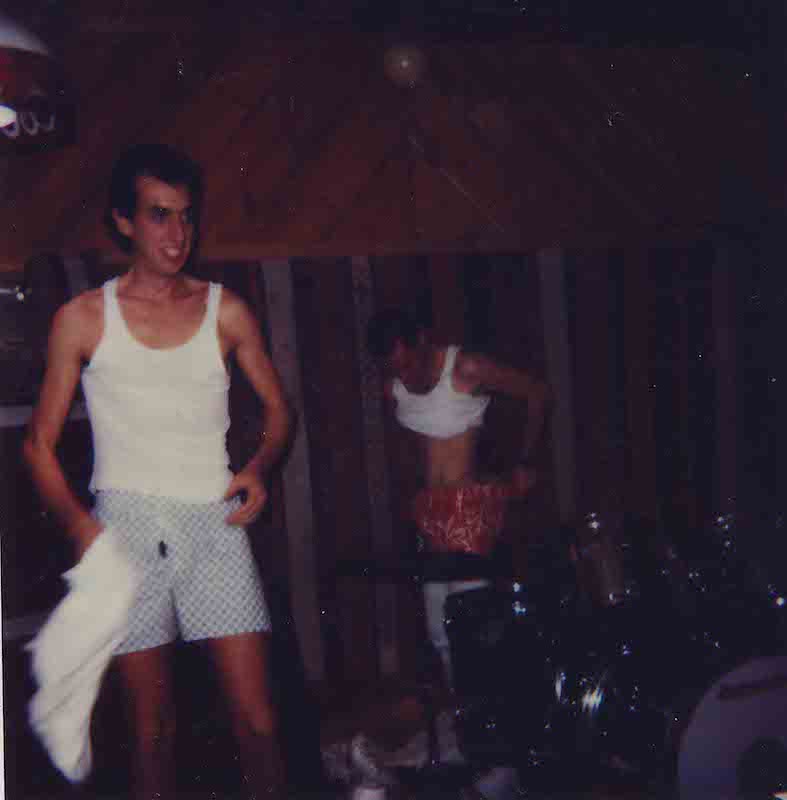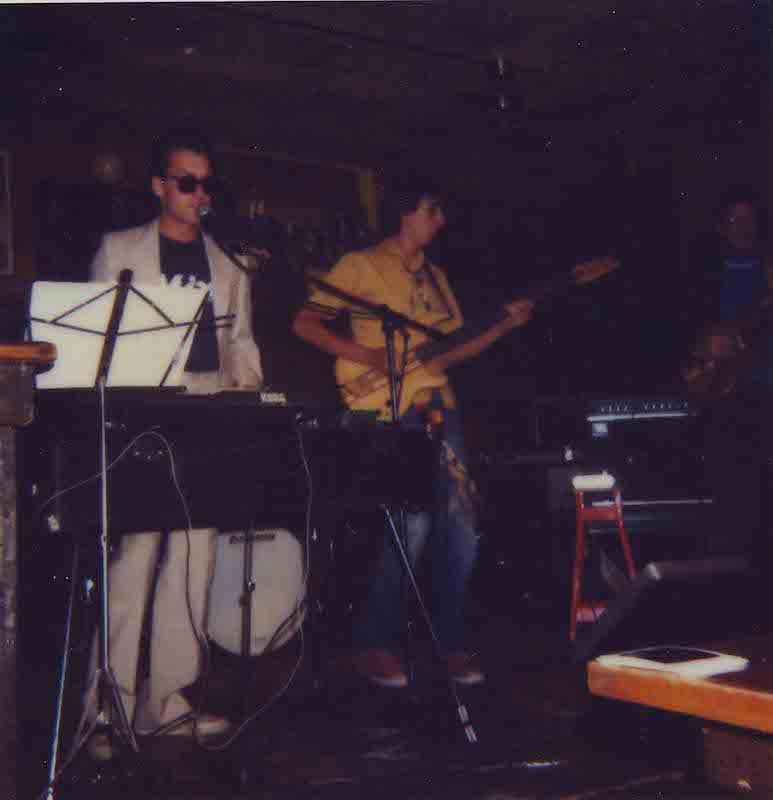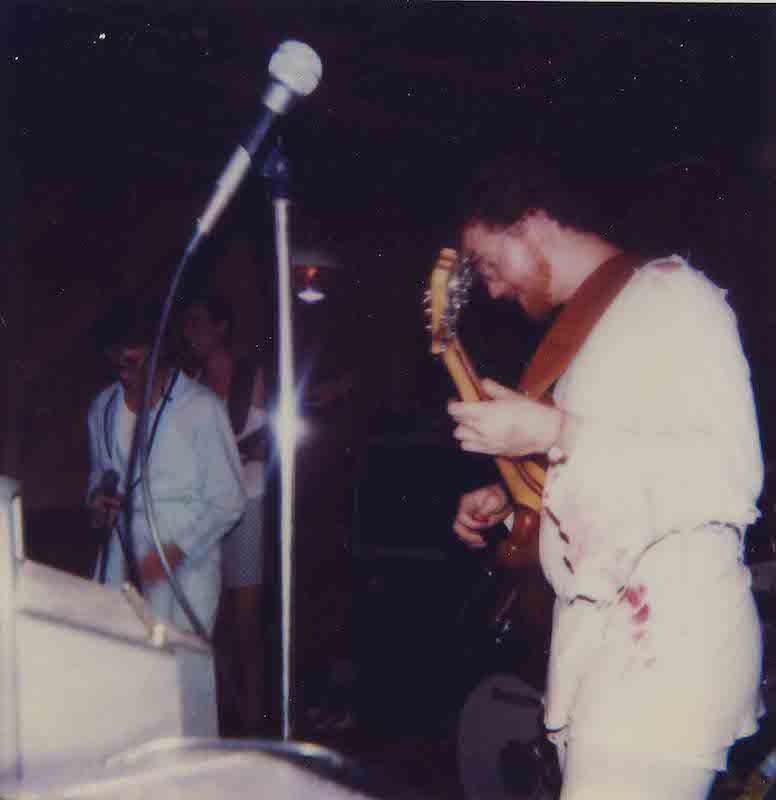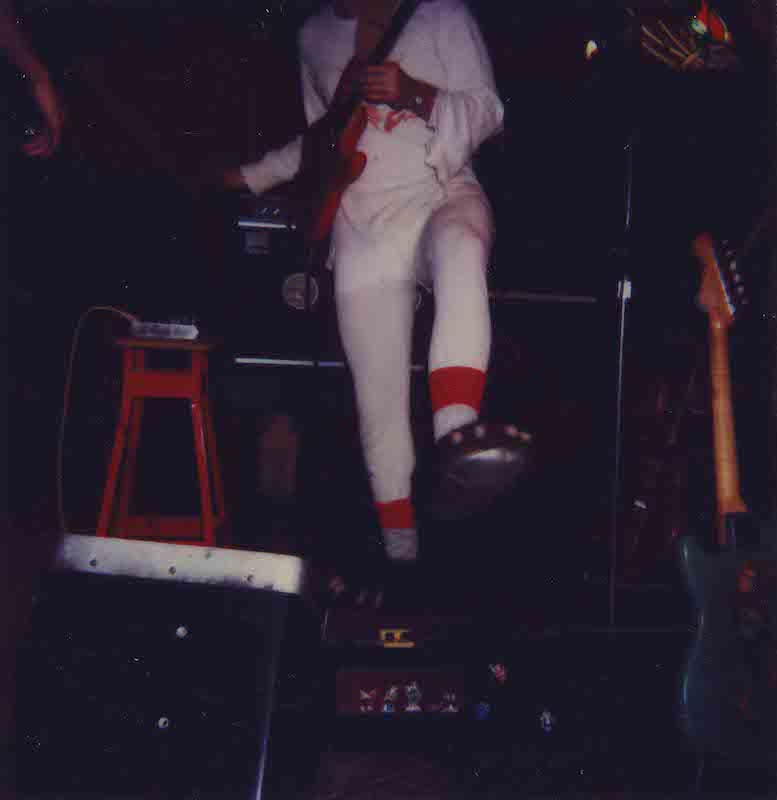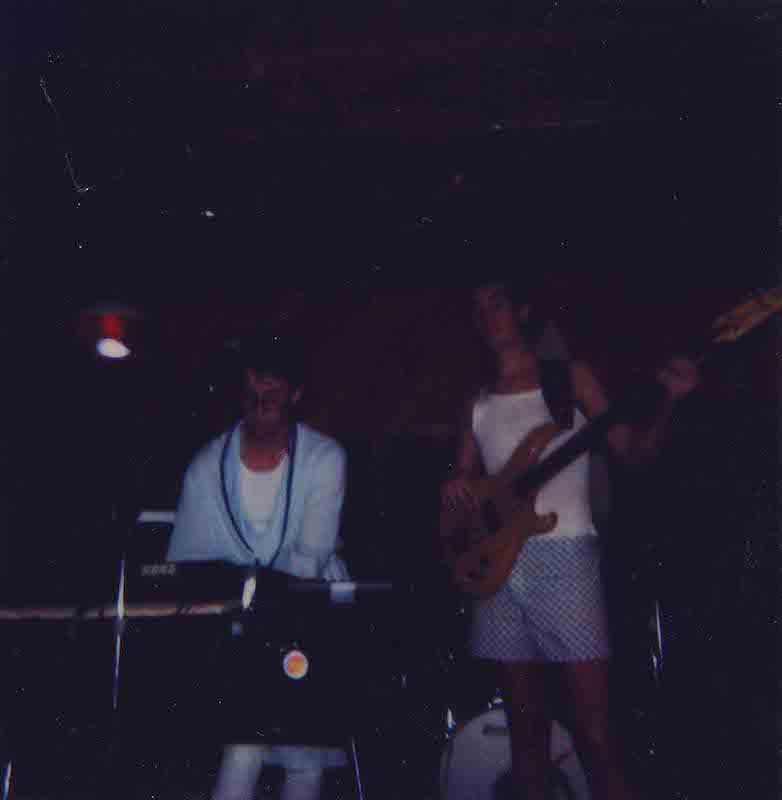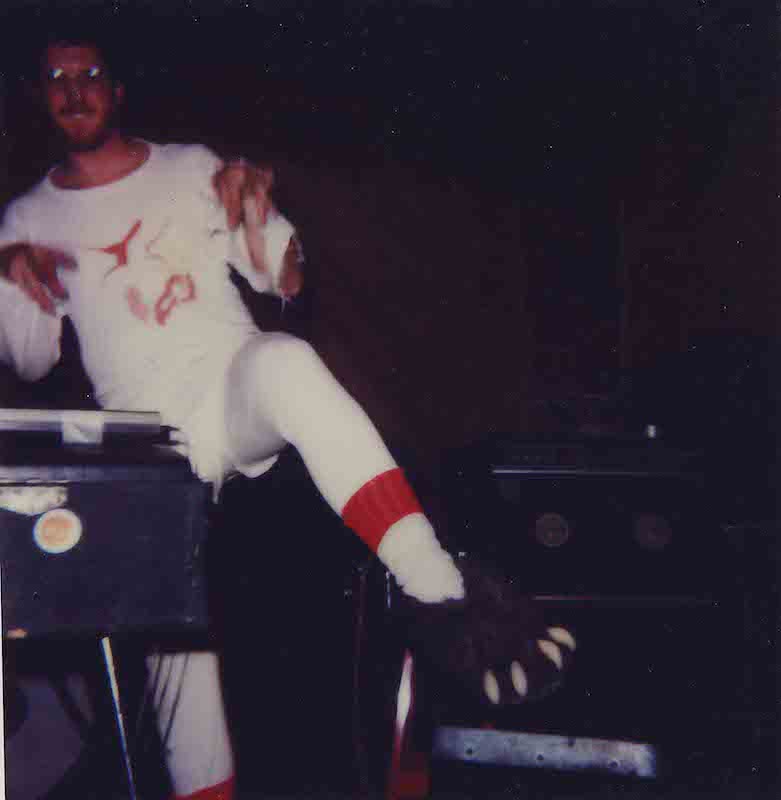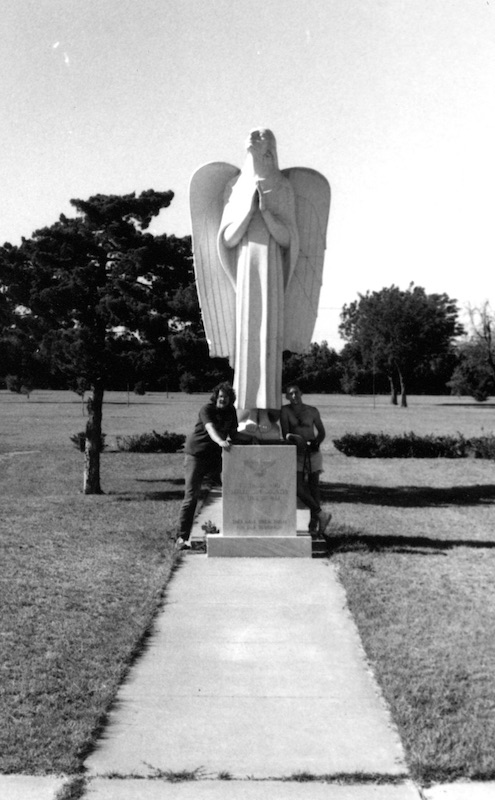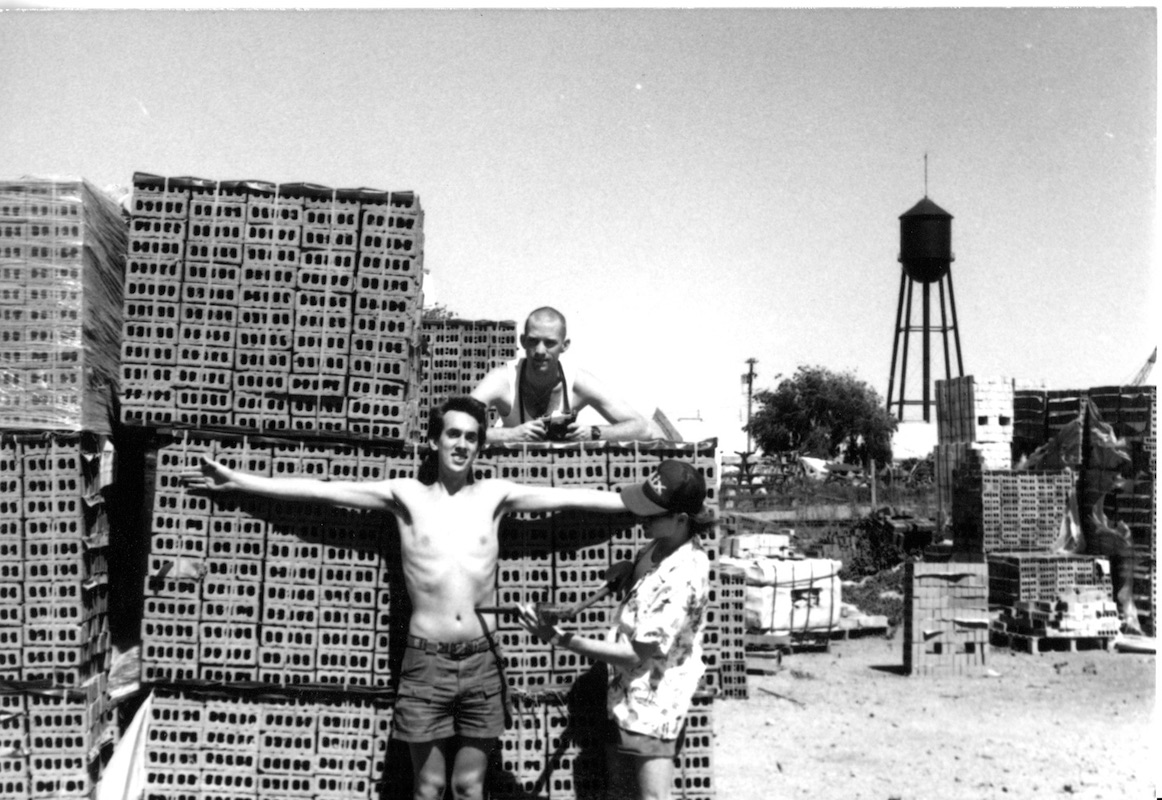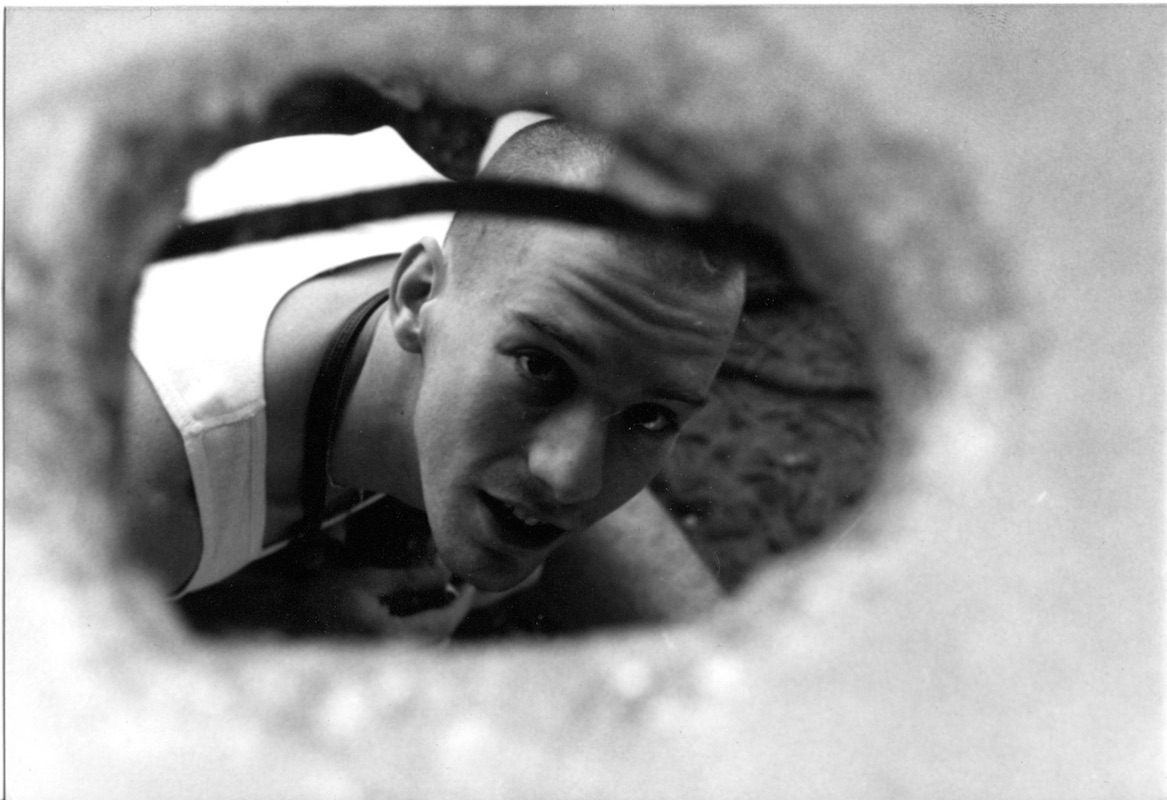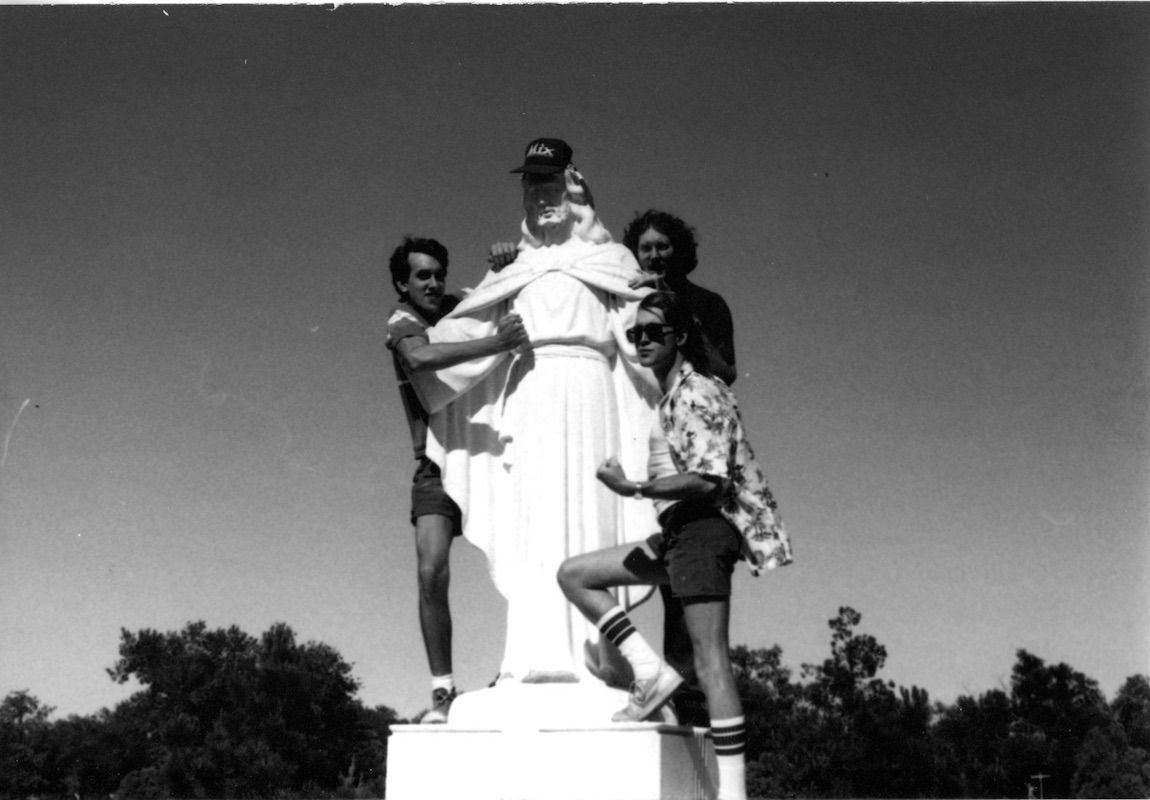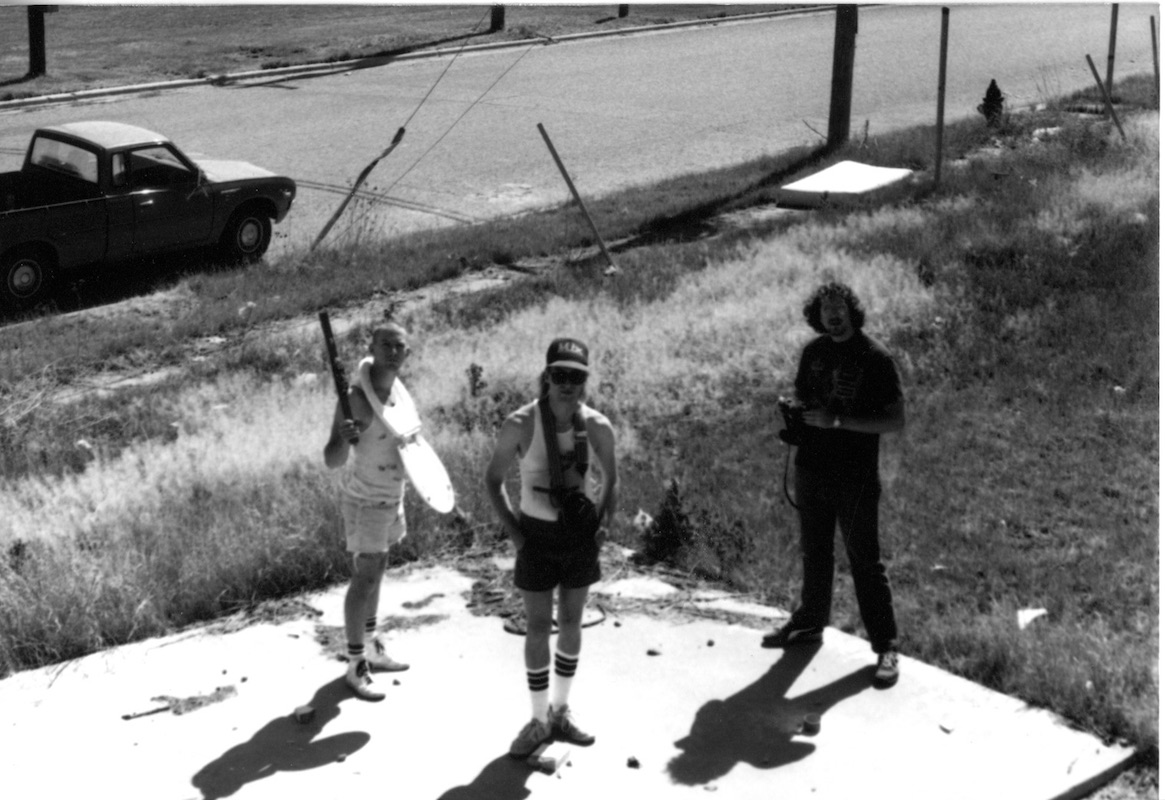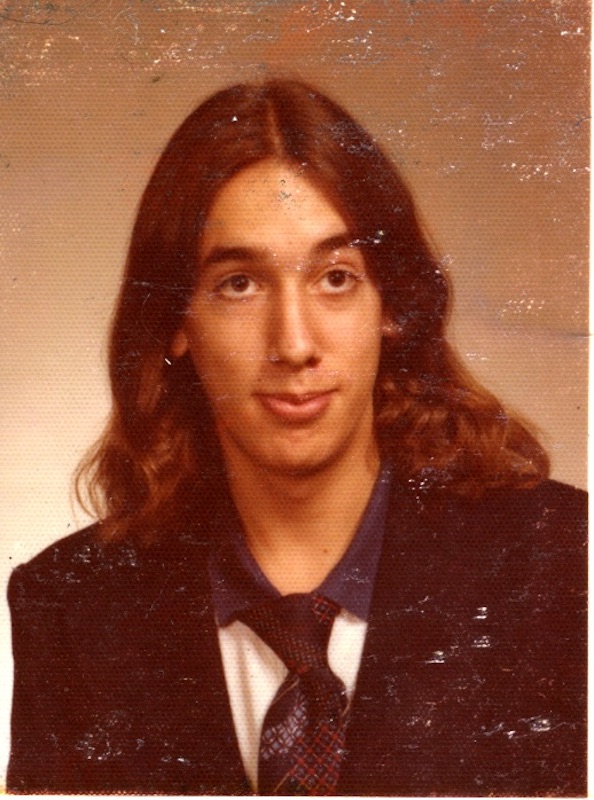
Asparagus Nightmares (2017 Remaster)
Lubbock’s purveyors of Upbeat Relief
Asparagus Nightmares established new sonic territory with their 1986 self titled debut album. This band paved the way for Lubbock, Texas’ underground music scene and their sound is just as relevant now as it was in the 80’s. The original stereo mixes have been lovingly remastered by ace recording/mastering engineer, Alan Crossland for Sonic Biscuit.

Tom Blackburn - Guitars, Vocals
Mark Matos - Basses
Mark Murray - Keyboards, Vocals
Johnny Ray - Drums
Guest Appearance by Rod Screamer (aka Don Caldwell) - Saxes
Recorded and Mixed at Don Caldwell Studios - Lubbock, Texas
Engineered and Produced by Don Caldwell and Mark Murray
Album artwork, photography and logo design - Robert Hudnall
Upbeat Relief
Sonic Biscuit is proud to offer Asparagus Nightmares, the first release in our Legacy Artist Series. This dynamic band incorporated a diverse set of musical influences into their original music, borrowing from rock, jazz, punk and psychedelia to create what they coined “Upbeat Relief”. Their self titled album was originally available only on cassette tape and was sold regionally at select record stores. This once obscure release is now available to digital age music listeners everywhere. The original stereo mixes have been lovingly restored and remastered to their original glory by mastering/audio engineer Alan Crossland. This full length album is now available for digital download/and streaming at most popular music services.
About the Band
From the proprietor. Here’s some information about the band as I remember it (please feel free to contact me if I stand corrected).
Asparagus Nightmares was formed in 1983 but has it’s roots in a band that was formed in high school by several of the lads. Tom Blackburn, Mark Matos and Johnny Ray began playing together in the late seventies as Igneous. Matos was the Student Program Director for KOHM radio, the Lubbock Independent School District owned, student operated radio station. On one of his DJ shifts he set the band up in the radio control room and they played live to the Lubbock listeners. I know little else about this band or what became of it, but that was the year I became friends with Matos. We were both in school at Dunbar-Struggs, the new magnet program school where we were in the high school jazz-rock ensemble and electronics programs.
Around 1980, now college age, the Igneous trio reassembled to form the band Dune. This combo featured Blackburn, Matos, Ray and myself. Dune was a jazz rock fusion band writing original instrumental music trying to get gigs in Lubbock. We rehearsed out of Matos’ mom’s house where she was extremely tolerant of our presence and noise level in the spare bedroom. After several months together, Johnny Ray was ousted from the band for his inability to put the band rehearsal schedule above the LA Raiders TV game schedule. This was handled with much ceremony by placing one of Matos’ old hiking boots on Johnny’s drum throne. He was at first confused and said “You’re giving me a boot?” then realized the meaning of the gift. “Oh! You’re kicking me out of the band!” Fortunately, Johnny didn’t hold a grudge. He was replaced by a music student from Texas Tech, drummer Alan Lawerance. This configuration of the band actually got out and did a few shows around Lubbock, most notably serving as the opening act for The Jeff Lorber Fusion at The Rox club.
In late 1982, Blackburn and myself attempted to start up a band with drummer Kevin Mackey and bassist Kevin Powell. The band, Flying House was short lived but survived long enough to get in the studio at South Plains College where I was attending school in their Sound Technology Program. We recorded one or two songs together for my student projects. Thus began a long and winding studio partnership between Blackburn and myself, not to mention the beginning of my life-long career as a recording engineer. Flying House never got beyond the little rear house apartment I was living in at the time because Mackey was given the opportunity to start playing with Lubbock’s own - The Nelsons. To top it all off, I was being kicked out of my little house because my landlord decided she wanted to live there. This event later became the creative impetus for a song.
In the wake of Flying House, Blackburn circled back up with Mark Matos and Johnny Ray and they started jamming in the shed in Johnny’s back yard. There was some interesting new sounds brewing. Matos was tuned into the early eighties incarnation of King Crimson and Ray was going out to see the punk bands that were making stops in Lubbock. Whatever was brewing must’ve been loud (or obnoxious, or both), because during a rehearsal there was a knock on the door from one of the fine officers of the Lubbock Police Department. The trio was greeted with a fine West Texas authoritarian “Boys, boys, boys. You’re gonna have to keep it down."
Sometime around late 1983 or early 1984, I was invited back into the fray. During a jam session we pondered why Dune had failed to garner much of a following. We came to several realizations. First off, instrumental jazz/rock fusion bands weren’t at the top of the “must hire” list for the local live music scene in Lubbock, Texas. Second, if you wanted to get any paying gigs, you needed to have a few recognizable cover tunes in your repertoire. We paid no attention to these realizations and carried on. Somewhere during this time, Blackburn shared a hallucinogen inspired event in which he was being stalked (no pun intended) by giant, raging asparagus. So we didn’t learn our lesson, but we did come up with a very unapproachable, yet unforgettable band name - Asparagus Nightmares. And we started practicing together - a lot!
Early on, we started getting invited to play at some of the local college house parties. The response was somewhat tepid at first, but we stayed our course. Eventually it became clear during one of these parties that we had better play something that would get people moving or we might not be playing any more parties. So Matos suggested we play “Louie Louie”. The beauty of that song is it existes in every musicians’ DNA. Pick a key and start playing, and you automatically execute “Louie Louie”. I started singing in tongues. I didn’t have the slightest idea what the words to the song were, but everyone was dancing, so we must have done something right. We wound up playing “Louie, Louie” about fifteen times. I think this might have been the tipping point where we realized our audience wanted to hear more energetic songs (songs - meaning with a singer), so I started writing lyrics and became a singer (still questionable). Meanwhile, we took the hint and started infusing more energy into our music. Thus our sound was born.

Asparagus Nightmares circa 1985 - L to R Tom Blackburn, Johnny Ray, Mark Matos, Mark Murray
We began a lengthy regimen of writing, practicing and playing for audiences. Most of our early gigs were college house parties and the venerable Main Street Saloon. This bar was the launch pad for nearly every Lubbock rock band in those days. It was a weird mix of folk - college students, bikers, hippies, punks, and rednecks. The saloon owner, Pyrrha Malouf took a shine to us, so it was pretty easy for us to get a booking there whenever we needed to play. We were writing music like crazy and used the Main Street Saloon as our test site. If we could get a rise out of the diverse crowd there, the song was a keeper. We soon had enough material to play a full night without having to dip into the cover tune reserves. Little by little our list of venues started to expand.
A collection of Asparagus Nightmares gig posters
A collection of photos of the band
Recording
In 1984 I started work as a staff engineer at Don Caldwell Recording Studios. I was given many opportunities there to work with some of the best talent in the region and had the supreme good fortune to have Don Caldwell and Lloyd Maines as mentors. I learned quickly and it wasn’t long before I was building my own list of clients. In 1985, we brought the band in to record a demo tape to help us garner some gigs. We had a lot of fun cutting the demo and it started the wheels turning in the our heads about maybe recording an album someday.
Later that year we all sat down and started planning a full on album project. We worked out a deal with Caldwell to record. We wanted him to engineer and produce, particularly the tracking of the rhythm sections and vocals. It was good to have an objective ear to help guide us and he poured a lot of energy into the sessions. For the most part the sessions were a lot of fun, but they were not without tense moments. Tom and I had borrowed money to pay for our portion of the project, so we were both feeling the pressure to perform. There were, no doubt, some passionate moments in the recording process but Don was instrumental in defusing tensions and getting us back on track. Aside from his engineering and production services, Don also lended his musical talents to the album, playing saxophone on “Rootman” and “Had Enough”. Since we were kind of an edgy rebellious lot, Don was cautious about having his name as an artist associated with the band, so he appears under the alias Rod Screamer in the original album credits. I think the solo he played on “Rootman” was some of the most innovative and free playing I can remember hearing from him.
One moment that I remember as a stand out in the production of this album was tracking Tom’s lead for “Better Off Dead”. Tom was always a very spirited and “in the moment" player, but you never knew what was going to come out of him when the record button was pushed. We set up his amp in the studio and turned it up really loud because I wanted his lead to capture an angry, murderous moment to match the spirit of the song. He played a couple of passes, and while good, it didn’t quite capture the anger I wanted to hear. Now Tom is a very peaceful, friendly guy so I wasn’t sure quite how to get him in the zone for this take. I remember directing him away from anything with conventional rhythmic or melodic content. I think the last thing I said to him before the magic take was executed was “What would Zappa do?” At the end of that take, Don and I just looked at each other with our mouthes hanging open. Boom! That take was magic and it makes an impact on anyone who listens to the album.
I don’t remember all the gear specifics of the session, but here’s what I recall. The studio was equipped with an MCI-JH600 console and MCI 2” 24 track and 1/4” 2 track tape machines. The outboard compliment included LA-2A compressors, Lexicon 224 Digital reverb, Lexicon PrimeTime delay unit (which I over-used on guitar parts), and Yamaha NS-10 monitors. Matos played Aria Pro II and Fender Jazz basses recorded direct with a Countryman DI, usually through one of the LA-2A’s. Blackburn was playing some sort of Strat with a Floyd Rose whammy/bridge through a Roland JC-120 amplifier. The studio owned a brand new Yamaha DX7 keyboard that I abused all over this record. I think my old Korg Poly-800 made some sounds as well. I believe Ray played the studio’s Yamaha kit.
The Product
With the completion of the recording and mixing process, it was time to get product in our hands. The decision had to be made as to what medium we wanted to produce. CD’s were brand new at the time and were prohibitively expensive to produce, particularly for independent artists like ourselves. We wanted to produce vinyl LP’s, but that was also a little out of our price range, so we settled for cassettes. As a cassette junkie of the day, I wanted to make sure we were getting the best possible quality we could. We opted to have the tapes done in clear “The Shape” cassette shells. These were superior shells with very high quality reels and tape guides. We also elected to have the tapes manufactured using Ampex chrome tape, something major labels almost never did.
Robert Hudnall was a graphic artist/photographer who had an office in the Caldwell Studios building. By benefit of proximity, he acquired a great deal of the album and promotional artwork from the artists recording at Caldwell’s. He was the natural pick for our project because he had a lot of experience with the printing and layout specs for cassette and LP production. He also just happened to be an incredibly talented artist. He did our band promo photo shoot at the studio. In addition to the familiar 8 x 10 band shot, he also did a series of individual photos of the band members. These pictures later became part of the album cover shoot.
We planned the album cover shoot to take place at Anthony Poe’s house. The shot featured an old Montgomery Wards black and white TV, a TV dinner, TV tray, lots of asparagus, twinkies, cigarettes, bones, model space shuttle, photos of the band members, ballet slippers, chess board, Matos’ old beat up Converse high tops and a lovely piece of asparagus inspired stained glass created by Betty Blackburn. The final album cover was retouched to feature a weird picture of Hudnall clasping a stalk of asparagus in his teeth on the TV screen.

The original cassette artwork
With a few cases of product in our hands, we needed to get out and sell cassettes. We wanted to do something to make our product stand out in the stores, so Hudnall came up with the brilliant idea of putting a wrapper around a five pound can full of tapes as a point of sale display. We made consignment deals with all the local record stores and our asparagus cans soon adorned the check out area of all the stores.

Point of sale display

Asparagus Nightmares promo poster
The Asparagus Nightmares cassette started to get some attention. We had a fan, Pete Wilkins, who was on staff with the Texas Tech campus paper (called The University Daily at the time) who gave us a favorable review in his “Rock Doctor” column. He was also involved with KTXT, the campus radio station and managed to get us in rotation. There were a couple of jocks from KFMX who were regular fixtures at our shows, so “Smashed and Killed to Death” and “Better Off Dead” were in heavy rotation on a few shows and soon, pretty much every show. William Kearns, entertainment editor of The Lubbock Avalanche Journal gave us a pretty extensive review and soon sales were starting to move pretty well. This generated enough attention that one of the local TV stations sent a crew out to film an interview with us at Caldwell Studios. It seemed like things were really starting to go our way.
Pete Wilkins was part of a very cool radio show he and Scott McMullan presented every week called “Theater of the Airwaves”. They featured lots of oddball stuff like Frank Zappa, Spike Jones, etc. We were a natural fit for their format and they did a full show interviewing us and playing the whole album. The show was great fun and surprisingly entertaining considering how off the cuff it was.
During this time the legendary artist/musician Terry Allen was working on projects at Caldwell Studios. I was engineering and playing synthesizer on a couple of his records and gave him a copy of our album. He was quite impressed with it. A few months later he asked if he could use some of our music in an art installation he was commissioned to work on. I agreed. As it turns out, he had been commissioned by the University of California San Diego to do an outdoor piece close to the library on their campus. The project ended up being three trees that had been covered in lead. Two were outfitted with speakers and a sound playback system, one to play spoken word (poetry, stories) and the other to play music. “Better Off Dead” and a song from a Christmas tape by Tom and I wound up playing in the ‘singing tree’, and continues to serenade the UCSD campus to this day.

The Trees at UCSD
There is a very cool interview/documentary about the creation of the Trees on The University of California TV archive. At around the 20:47 minute mark, Terry discusses his selection of music for the “Singing Tree” and made some nice comments about Asparagus Nightmares specifically. Click on the picture above to view the documentary.
Late Model Asparagus Nightmares
We continued to gig and promote our album for about a year when we hit our first major fork in the road. Matos had completed his Masters Degree and was ready to go out into the world to pursue his career in Electrical Engineering Technology. The decision was made to continue on, but it was rocky. Johnny was becoming bored with playing drums and was wanting to pursue bass. Matos left large shoes to fill and while Johnny was an adequate bass player, he wasn’t bringing the aggressive confidence to the position that it once had. We tried out a couple of drummers, including one John Wilson, who later becomes drummer for Four Stories Tall, but Tom nixed him because he was having trouble with one or two of the songs.
It was starting to look rather hopeless and Johnny seemed to be moving on to other pursuits. Tom and I wanted to stay the course, so we continued looking for players. After a lot of auditions, we eventually landed on a good combination for our rhythm section. Kevin Kelly was a bass player attending South Plains College whom I stumbled upon in one of the commercial music ensembles. He had a lot of promise as a player and had the added benefit of being a singer and writer. Steve Silvia rounded out the ensemble as a very solid drummer and very reliable and eager participant in our newly re-tooled ensemble.
We started learning the lesson about breaking in new players in a prog rock/originmal music band. You can’t just hand them a cassette tape of all the songs and say “go learn these”. The majority of our music wasn’t recorded, so we just had to kinda reinvent all the songs. And since the new players brought their own style to the band, many of the old tunes were getting pushed aside for new songs. After several months in the rehearsal room, the band started geting out and playing again.
I was eager to get back in the studio so we went back to Caldwell’s in late ’86 for a four song demo. The recording went well and allowed us to get a feel for what it was to be like with the new line up in the studio. We continued to gig around Lubbock, but the audiences weren’t as strong as they had been in the past. Without Johnny, our promotional machine had lost some of it’s potency. At some point soon after, some disagreement within the band led to the ousting of Kevin Kelly.
Once again we needed to fill an empty slot in the band. We tried out a young and exuberant bassist by the name of Kevin Powell. He was a pretty good fit and had a lot of potential. Then I found out one of my best friends, Chris Carson was back in Lubbock. I really wanted him in the band as we had an early history of playing together. I forced the issue and Powell was cut loose. Carson proved to be an unreliable player and I think Tom and Steve were a bit miffed at me for rejecting a perfectly good bass player for my old friend. Needless to say, that was pretty much the straw that broke the camel’s back. Weary of personnell changes and struggles to regain our popularity, the band dissolved.
RIP, Asparagus Nightmares.
